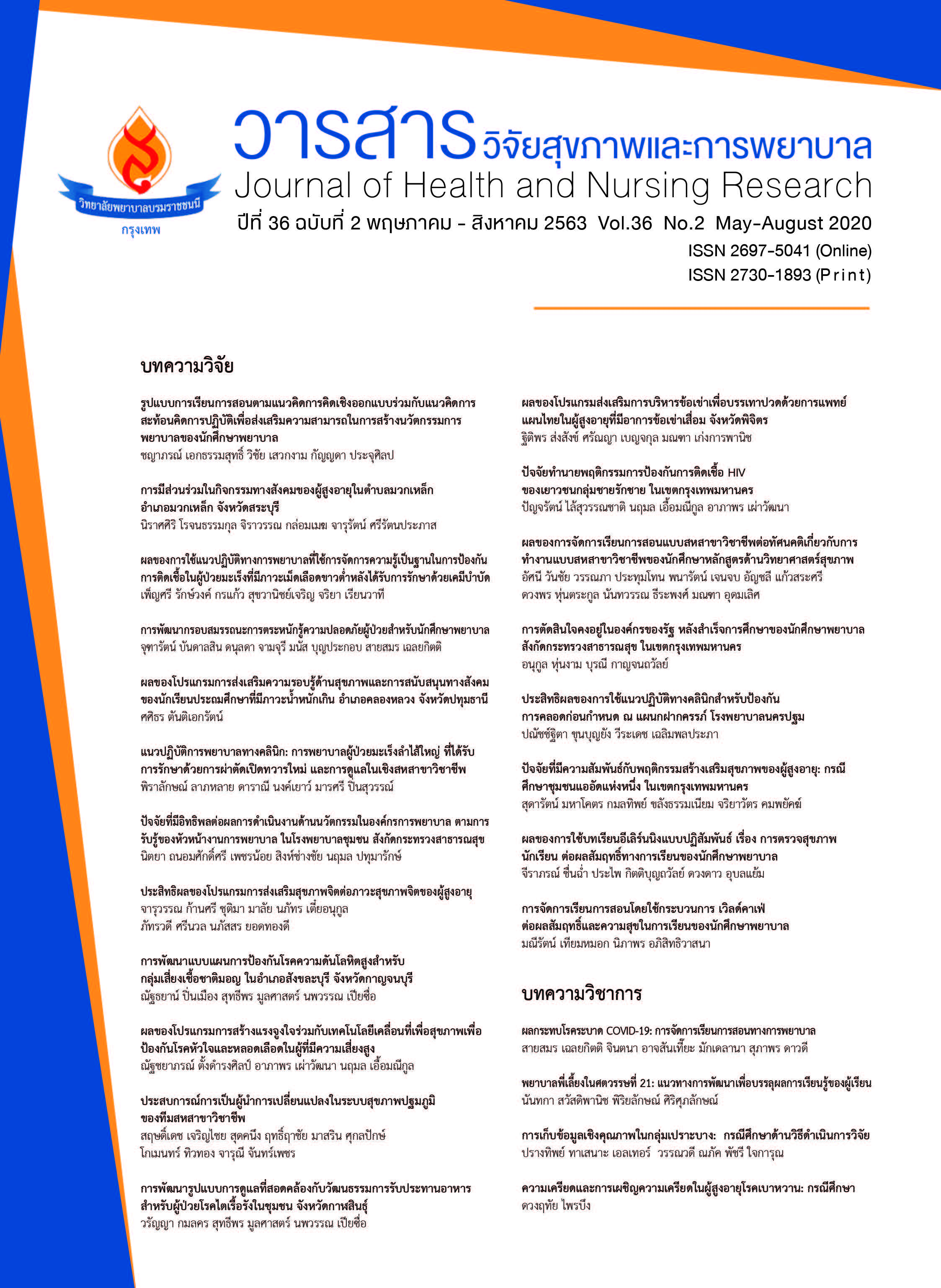แนวปฏิบัติการพยาบาลทางคลินิก: การพยาบาลผู้ป่วยมะเร็งลำไส้ใหญ่ที่ได้ รับการรักษาด้วยการผ่าตัดเปิดทวารใหม่ และการดูแลในเชิงสหสาขาวิชาชีพ
คำสำคัญ:
แนวปฏิบัติการพยาบาลทางคลินิก, ผู้ป่วยมะเร็งลำไส้ใหญ่, การดูแลผู้ป่วยมีทวารใหม่บทคัดย่อ
งานวิจัยครั้งนี้มีวัตถุประสงค์เพื่อศึกษาผลของการใช้แนวปฏิบัติการพยาบาลทางคลินิกด้านการพยาบาลผู้ป่วยมะเร็งลำไส้ใหญ่ที่ได้รับการรักษาด้วยการผ่าตัดเปิดทวารใหม่ต่อการฟื้นหายและอัตราการเกิดภาวะแทรกซ้อนภายหลังการผ่าตัดโรงพยาบาลพระนครศรีอยุธยา กลุ่มตัวอย่างคือผู้ป่วยที่ได้รับการวินิจฉัยว่าเป็นมะเร็งลำไส้ใหญ่และได้รับการรักษาด้วยการผ่าตัดเปิดทวารใหม่ จำนวน 60 ราย เลือกกลุ่มตัวอย่างแบบเฉพาะเจาะจง การสร้างแนวปฏิบัติการพยาบาลทางคลินิก พัฒนาจากการวิเคราะห์ สังเคราะห์จากหลักฐานเชิงประจักษ์ในการพยาบาลของซูคัพและใช้แนวคิดการจัดการอาการของดอดด์และคณะ มาเป็นกรอบแนวคิดในการศึกษาผลของการใช้แนวปฏิบัติการพยาบาลทางคลินิก ติดตามผลหลังจากการใช้แนวปฏิบัติฯ ในระยะ 24 ชั่วโมง 7 วัน 14 วัน และ 30 วัน เครื่องมือที่ใช้ในการวิจัยประกอบด้วย 1) เครื่องมือที่ใช้ในการดำเนินงานวิจัย ได้แก่ แนวปฏิบัติการพยาบาลทางคลินิก 2) เครื่องมือที่ใช้ในการเก็บรวบรวมข้อมูล ได้แก่ แบบประเมินภาวะทุพโภชนาการ Bhumipol Adulyadej hospital Nutritional Triage (BNT) แบบประเมินความรุนแรงของผิวหนัง (SACSTM) แบบประเมินการทำงานของลำไส้ และแบบประเมินความพึงพอใจของผู้ป่วยและญาติ วิเคราะห์ข้อมูลด้วยสถิติเชิงบรรยาย และวิเคราะห์ความแปรปรวนทางเดียวแบบวัดซ้ำ (one–way repeated measures ANOVA) ผลการวิจัยพบว่า ค่าเฉลี่ยคะแนน BNT ค่าเฉลี่ยคะแนน SACSTMและค่าเฉลี่ยคะแนนการทำงานของลำไส้ของผู้ป่วยมะเร็งลำไส้ใหญ่ภายหลังได้รับการดูแลตามแนวปฏิบัติการพยาบาลทางคลินิก ในระยะ 24 ชั่วโมง 7วัน 14 วัน และ 30 วันมีความแตกต่างกันอย่างมีนัยสำคัญทางสถิติ และค่าเฉลี่ยคะแนนความพึงพอใจของผู้ป่วยภายหลังได้รับการดูแลตามแนวปฏิบัติการพยาบาลทางคลินิกระยะ 24 ชั่วโมง และ30 วันมีความแตกต่างกันอย่างมีนัยสำคัญทางสถิติ
Downloads
เอกสารอ้างอิง
2. Arnold M, Sierra MS, Laversanne M, Soerjomataram L, Jemal A, et al. Global patterns and trends in colorectal cancer incidence and mortality. Gut 2017;66:683-91.
3. Bray F, Ferlay J, Soerjomataram I, Siegel RL, Torre LA, et al. Global cancer statistics 2018: GLOBOCAN estimates of incidence and mortality worldwide for 36 cancers in 185 Countries. Ca Cancer J Clin 2018;10:267-84.
4. National Cancer Institute Department of Medical Services Ministry of Public Health. Hospital -based cancer registry. [Internet]. 2018 [cited 2018 January 7] Available fromhttp:// www.nci.go.th/th/cancer_record/cancer_rec1.html.
5. Prechaterasat A. Enterostomal therapy nurse’s role: case study in nursing care for rectal cancer patients. Thai Red Cross NursJ 2018;10(1):8-24. (in Thai)
6. Kiattisin P, Kasemkitwattana S, Chayaput P. Postoperative recovery in patient with abdominal surgery: an integrative review. Thai Journal of Nursing Council 2010;25(2):87-99. (in Thai)
7. Sritan S, Utriyaprasit K, Toskulkao T, Akaraviputh T. Predictive factors in postoperative recovery abdominal surgery patients. Thai Journal of Nursing Council 2014;29(2):21-35. (in Thai)
8. Ljungqvist O, Scott M, Fearon K. Enhanced recovery after surgery: a review. JAMA Surg 2017;152(3):292-8.
9. Grant MC, Yang D, Wu C, Makary MA, Wick EC. Impact of enhanced recovery after surgery and fast track surgery pathways on healthcare-associated infections: results from a systematic review and meta-analysis. Ann Surg 2017;265(1):68-79.
10. Lau CS, Chamberlain RS. Enhanced recovery after surgery programs improve patient outcomes and recovery: a meta-analysis. World J Surg 2017;41(4):899-913.
11. Pibul K, Techapongsatorn S, Thiengthiantham R, Manomaipiboon A, Trakulhoon V. Nutritional assessment for surgical patients by Bhumibol Nutrition Triage (BNT). Thai J Surg 2013;32:45-8. (in Thai)
12. Dodd M, Miaskowski C, Paul S. Symptom clusters and their effect on the functional status of patients with cancer. Oncology Nursing Forum 2001;28(3):465-70.
13. Soukup M. The center of advanced nursing practice evidence-based practice model. Nursing Clinic of North Amesica 2000;35:301-9.
14. Chaithat B. Caring for colorectal cancer patients undergoing ostomies: roles of enterostomal therapy nurses. Thai Red Cross NursJ 2017;9(1):19-33. (in Thai)
15. Phamornpon S. The role of nurses in promoting early postoperative ambulation. Thai Red Cross NursJ 2017;9(2):14-23. (in Thai)
16. Stoma care handbook 2016-2017 in Association with Gastrointestinal nursing. [Internet]. 2016 [cited 2017 Mar 6] Available from: http://magsubscriptions.com/stoma-care-handbook-2016-2017.
17. Charter of ostomates rights. [Internet]. 2004 [cited 2017 Mar 6] Available from: http://www.ostomy.org/Ostomate_Bill_of_Rights.html.
18. Jarayapan R, Cheupan K, Trakunhun W. Screening and assessment of patients with or at risk of hospital malnutrition. 2006. (in Thai)
19. European Society of Parenteral and Enteral Nutrition (ESPEN). ESPEN workshop nutritional screening and assessment. [Internet]. 2015 [cited 2017 January 20]
20. Mario A, Gaetano M, Silvia M, Raimondo A, Stefano V, et al. SACS 2.0: a proposal for the classification of peristomal skin disorders. Results of a multicenter observational study. Acta Vulnologica 2016;14(3):140-51.
21. Hiroki O, Julie KF, John S, Sumit R, Michael DL. Effectiveness of Devices Purported to Reduce Flatus Odor. Am J Gastroenterol 2006;100(2):397-413.
22. Larsen DL, Attkisson CC, Hargreaves WA, Nguyen TD. Assessment of client/patient satisfaction:development of a general scale: Eval Program Plann 1979; 2(3):197-207.
23. Kongsakon R, Jareonsettasin T. Reliability and validity of a new measure of patient satisfaction (CSQ-8) Thai version with psychiatric care: Journal of the Psychiatric Association of Thailand. 2000;45(2):155-63. (in Thai)
24. Poulia KA, Yannakoulia M, Karageorgou D, Gamaletsou M, Panagiotakos DB, et al. Evaluation of the efficacy of six nutritional screening tools to predict malnutrition in the elderly. Clin Nutr 2012;31(3):378-85.
25. Rasmussen HH, Holst M, Kondrup J. Measuring nutritional risk in hospitals. Clin Epidemiol 2010;2:209-16.
26. Ryu SW, Kim IH. Comparison of different nutritional assessments in detecting malnutrition among gastric cancer patients. World J Gastroenterol 2010;16(26): 3310-17.
27. Nguyen LT, Yates P, Annoussamy LC, Truong, TQ. The effectiveness of non-pharmacological interventions in the management of symptom clusters in adult cancer patients: a systematic review protocol. JBI database of systematic reviews and implementation reports 2016;14(4):49-59.
28. Dahal A, Meheta RK. Fatigue experience and coping strategies among cancer patients receiving chemotherapy. J Nepal Helth Res Counc 2018;16(40):285-90.
29. Taweeyanyongkul N, Chaiviboontham S, Sumdaengrit B. Symptom Experiences and Symptom Management in Patients with Advanced Cancer Receiving Palliative Care. Rama Nurs J 2015;21(1):82-95. (in Thai)
30. Phamornpon S. Quality of life in patients with permanent colostomies: a challenge to nursing roles. Thai Red Cross NursJ 2018;33(4):19-32. (in Thai)
31. Maneesin S, Sampatanukulb P, Lertmaharitc S, Nagarad C, Prasopsantie K. Health-related quality of life of patients living with ostomy in Thailand and cost implications. AsianBiomed 2012;6(2):235-43.
32. Roshini AP, Sunny A, Rozario AP. Quality of life assessment in stoma patients in a tertiary care hospital in South India: a cross-sectional study. Int Surg J 2017;4(6):2037-41.
ดาวน์โหลด
เผยแพร่แล้ว
รูปแบบการอ้างอิง
ฉบับ
ประเภทบทความ
สัญญาอนุญาต
บทความที่ได้รับการตีพิมพ์ เป็นลิขสิทธิ์ของวารสารวิจัยสุขภาพและการพยาบาล (วิทยาลัยพยาบาลบรมราชชนนี กรุงเทพ) ไม่สามารถนำไปตีพิมพ์ซ้ำในวารสารฉบับอื่น


















